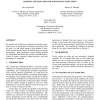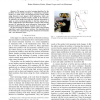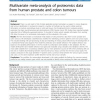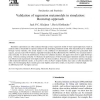105 search results - page 10 / 21 » Model selection by sequentially normalized least squares |
WSC
2000
13 years 9 months ago
2000
We present and evaluate two ranking-and-selection procedures for use in steady-state simulation experiments when the goal is to find which among a finite number of alternative sys...
ICRA
2010
IEEE
13 years 6 months ago
2010
IEEE
— We present an active learning algorithm for the problem of body schema learning, i.e. estimating a kinematic model of a serial robot. The learning process is done online using ...
BMCBI
2010
13 years 7 months ago
2010
Background: There is a vast need to find clinically applicable protein biomarkers as support in cancer diagnosis and tumour classification. In proteomics research, a number of met...
EOR
2006
13 years 7 months ago
2006
Simulation experiments are often analyzed through a linear regression model of their input/output data. Such an analysis yields a metamodel or response surface for the underlying ...
ICML
2007
IEEE
14 years 8 months ago
2007
IEEE
Kernelizing partial least squares (PLS), an algorithm which has been particularly popular in chemometrics, leads to kernel PLS which has several interesting properties, including ...




